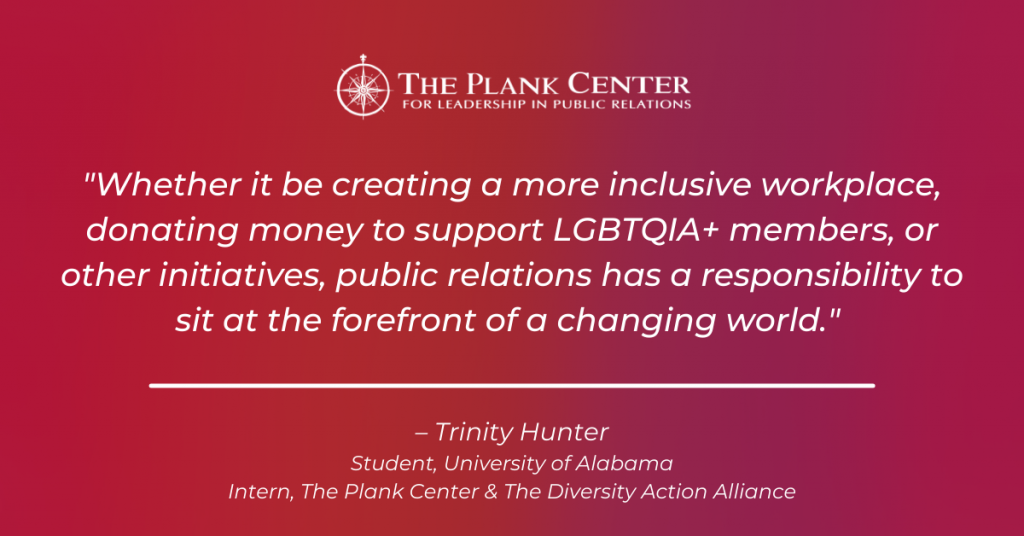By Trinity Hunter | June, 2021
While Pride Month is coming to an end, it is imperative that we take a look at the history of the LGBTQIA+ community within the United States. To many, the month of June is one of celebration. It marks the time of parades, when companies will release their latest rollout of rainbow-themed products. However, the story of Pride is one of struggle and triumph. It is a disservice to all who came before this point to not highlight it in a fuller capacity.

So…how did Pride come to be?
The month of June commemorates the efforts of those at the Stonewall uprising in 1969. Widely recognized as the catalyst of the modern gay rights movement within the United States, Stonewall, also known as the Stonewall Riots, took place in response to a police raid during the early hours of June 28. Patrons of the Stonewall Inn, a safe haven for homeless youths and drag culture, retaliated by throwing objects at the officers while being arrested. This interaction exploded into days of protests.
Marsha P. Johnson and Sylvia Rivera, both transgender women of color, are credited with throwing the first items at Stonewall, and thus serving as the leaders of this particular moment in the liberation movement.
Initially, Pride Month took place in October. The reasoning behind this stemmed from the fact that “National Coming Out Day” is October 11. However, President Bill Clinton decided that June should hold the title of “Gay and Lesbian Pride Month” in recognition of the Stonewall Riots. In 2009, the official name of the month was changed to “Lesbian, Gay, Transgender and Bisexual Pride Month” by former president Obama’s administration.
How does pride play into the professional space?
As is the case with most marginalized communities, professional spaces leave something to be desired when it comes to supporting members of the LGBTQIA+ community in the workplace. While some companies might opt for the easier, don’t ask, don’t tell policy, more and more people are coming forward to state that these efforts are not enough.
Dibs Baer of The Muse listed 11 ways to create a more inclusive environment for workers within this community. The tips range from asking about pronouns to being unafraid to make mistakes, as long as one makes a concerted and immediate effort to rectify the situation. However, perhaps the most notable points on the list, as it pertains to allyship, are #9 and #10.
In #9, Baer tells the reader that they must “stick up for [her].” She goes on to say that having zero tolerance for homophobic or transphobic jokes is how things will change. In #10, she reminds the audience to “show [they] care about the LGBT community.” Ways of doing this range from monetary donations to using one’s privilege of allyship to advocate for more inclusive policies within the workplace. Actions like these are imperative to creating a safer environment for colleagues, whether they be out or not.
What role does the PR world have in creating a better world for the LGBTQIA+ community?
According to the Public Relations Society of America (PRSA), public relations is “a strategic communication process that builds mutually beneficial relationships between organizations and their publics.”
Though the practice of public relations is not new, companies have been presented with a renewed need for adequate PR campaigns. Social media has changed the approach to dispersing and comprehending information. The difference between having a strong or weak public relations team has the potential to make or break a company.
While the pressure is considerable, so is the potential. For one, businesses should stop commodifying the rainbow symbol and instead work towards real structural change. Perhaps moves could be made to create more supportive spaces for LGBTQIA+ people, or allies within the organization could use their privilege to call for an analysis of company policies and how they may be inherently discriminatory.
The application of PR is broad and ever-changing. This presents the unique freedom to continue maneuvering its parameters in accordance to the world we live in today.
Beyond June, what efforts are there to support the LGBTQIA+ community? Are the necessary conversations being had and the systemic changes being made? Is there an intentional push to go beyond diversity and stretch the work towards equity and inclusion?
Whether it be creating a more inclusive workplace, donating money to support LGBTQIA+ members, or other initiatives, public relations has a responsibility to sit at the forefront of a changing world. Few sectors have the power to influence public opinion that public relations has–it’s time to utilize that power to the fullest extent.
Trinity Hunter is a junior at the University of Alabama studying public relations and political science. This summer, she is interning for The Plank Center for Leadership in Public Relations and the Diversity Action Alliance. She is passionate about learning new topics in the changing world around her and has a special interest in diversity, equity and inclusion work.